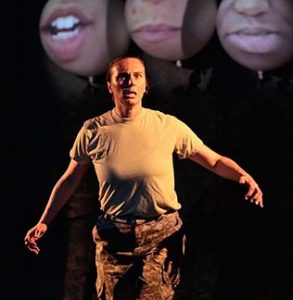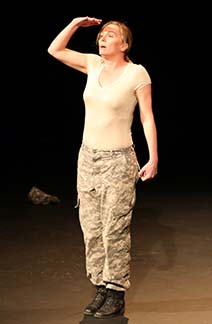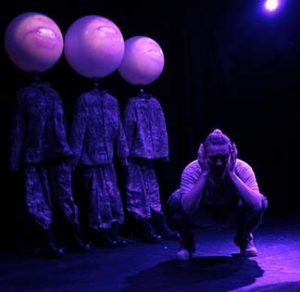By Lucy Komisar
Rebecca Johannsen‘s “Women at War” cuts to the heart of the irony of American military women serving in Afghanistan to relate to women in one of the most benighted anti-female countries in the world.

The women in the U.S. Army’s Female Engagement Team, deployed to Afghanistan in 2012-2013, were supposed to engage with local Afghan women to build relationships (hearts and minds) and also gather intelligence. Advanced Americans, oppressed Afghanis.
The backdrop is three camouflage-garbed figures with heads of balloons on which will inventively be projected moving features. In a corner is a stack of sandbags topped by a pair of boots. The set and costumes are by Mayou Trikerioti.
Johannsen wears camouflage pants, a t-shirt and a pony tail. The voices she speaks are pulled together from interviews with women who joined the U.S. armed forces and found that though they were supposed to be fighting stereotypes, they got caught in them. The American women suffered from sexism U.S. military style: no burqas, but plenty of what underlies them.

One soldier is from a small town in Texas. She had no opportunity for education, no option except marriage, kids, drugs, and Walmart.
In training for Afghanistan, males try to break women‘s spirit. One woman, trained as a medic, makes a tough climb up a mountain after a soldier there is hit by an IED, an explosive device. A male officer gets angry. How dare she show herself to be better than men?
A male officer has affairs with four or five female officers. Use of power or authority?
Johannsen repeats the story of the soldiers who spied on nude female troops and put their photos on a Facebook page. The balloon faces scowl.
In some villages, people are starving, have nothing. A sensible woman disobeys a captain to bring a man a bandage and an antibiotic cream for his kid. No reason given for the captain‘s orders, except he is in charge. The way to win hearts and minds.
Afghani men vent their sexism in all directions. The women soldiers are harassed by them hissing “ch ch ch” at them.

An Afghani woman who trained to be policewoman to feed her family is shot and killed. When U.S. authorities at a checkpoint demand that a woman in a burqa show her face and she refuses, the man with her slaps her.
Johannsen is good at bringing these characters to life. My only quibble is her portrayal of soldiers who appear to suffer PTSD (post-traumatic stress disorder). Her depiction of their “losing it” is done via bizarre spastic moves that come across only as weird. But for audiences who don‘t know what America‘s female military have endured, this is an important play.
“Women at War.” Written, directed and performed by Rebecca Johannsen. C Cubed, Edinburgh Festival Fringe. August 2017. 8/18/17.

